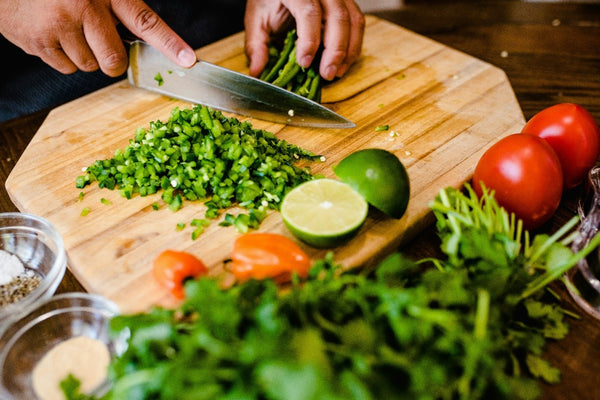
In the world of culinary arts, mastering basic knife skills is an essential element for those aiming to excel as a cook. A profound grasp of cutting techniques not only speeds up the cooking process, but also elevates the excellence and refinement of the end result. In this blog, we explore the significance of refining knife skills and offer invaluable guidance on harnessing this indispensable instrument in the kitchen.
How to Hold a Knife?
Before we go into cutting techniques, it is vital to focus on the right way to hold the knife. You need to have a proper grip on the knife. The handle should rest comfortably in the palm, with fingers wrapped securely around it. Maintain a firm yet relaxed grip, and ensure your posture allows for a stable and controlled cutting motion. Start with a smaller knife until you gain some confidence.
1. The Claw Technique:
To safeguard your fingers during cutting, you could use the claw technique. Curl your fingertips inwards, using your knuckles as a guide for the blade. This technique ensures precise control over the knife while minimizing the risk of accidental cuts.
2. Mastering the Rock Chop:
The rock chop is a fundamental cutting technique where the knife's tip remains in contact with the cutting board while the blade rocks back and forth. When you master this motion you will be able to effectively chop herbs, vegetables, and other ingredients.
3. Slice, Dice, and Julienne:
Understanding the distinctions between slicing, dicing, and julienning is the first step. Slicing involves cutting ingredients into thin, uniform pieces. On the other hand, dicing results in small, cubed cuts, while julienning produces long, thin strips. Proficiency in these cutting techniques makes you a versatile chef.
Tips for Using the Knife Correctly:
1. Sharp Blades:
Keep your knives sharp. Yep, even as a beginner you should use a sharp knife. In fact, a dull blade not only impedes efficiency but also poses a greater risk of accidents. Regular sharpening is essential for maintaining the edge and precision of your knives.
2. Respect the Blade:
Treat your knife with respect. Don’t use it for things beyond its intended purpose, such as prying open containers or cutting through bones. This preserves the blade's longevity and effectiveness.
3. Stable Cutting Surface:
Ensure a stable cutting surface to prevent accidents. A non-slip cutting board provides a secure base for your knife work, reducing the likelihood of slips or unexpected movements.
4. Practice Patience:
Cultivate patience in your cutting technique. Rushing through the process increases the risk of imprecise cuts and potential injuries. Take the time to focus on each motion, refining your skills with intentional practice.
Why knife skills are critical?
At the heart of any successful culinary creation are key tangible elements, chief among these is the skilful use of a knife. Knife skills are more than just cutting techniques; They are the foundation upon which chef skills are built. The ability to place the knife accurately not only speeds up the cooking process but also keeps the ingredient sizes accurate, resulting in even cooking and balanced flavours.
1. Accuracy & Precision in Chopping:
Basic knife skills empower the chef to produce ingredients with accuracy and precision. Perfectly chopped vegetables, evenly chopped proteins and finely chopped vegetables not only look attractive but also contribute to a more harmonious blend of flavours in the final dish.
2. Time Management:
A skilled hand with a knife turns a difficult and time-consuming task into a quick and efficient effort. The time spent on careful chopping and slicing is greatly reduced, giving the chef more time to focus on other aspects of cooking.
3. Safety in Kitchen:
Proficiency in knife skills is directly proportionate to better safety in the kitchen. A cook who understands the proper techniques is less likely to hurt themselves or experience any kind of accident, as they navigate the cutting process with confidence and control.

